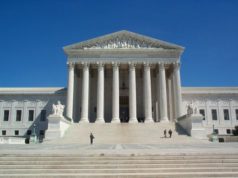
The Supreme Court of the United States has been tasked with making decisions on some of the most important and controversial issues affecting Americans. Over the years, the Court has been called upon to address various issues, including obscenity laws. Specifically, the Supreme Court has been tasked with determining the constitutionality of laws that are designed to regulate the distribution and dissemination of sexually explicit materials. This article will explore the various decisions that the Supreme Court has made regarding obscenities and how they relate to the constitutional rights of Americans.
One of the earliest cases that the Supreme Court was tasked with addressing regarding obscenities was the 1957 case of Roth v. United States. The case involved an individual named Samuel Roth who had been convicted of mailing obscene materials to individuals. Roth had argued that the materials were not obscene and therefore, his conviction should be overturned. The Supreme Court, in a 6-3 decision, ruled against Roth, stating that obscenity was not protected by the First Amendment.
The Supreme Court established a three-part test to determine what constituted as obscene material. The test included determining, based on contemporary community standards, whether the material appealed to prurient interest, whether the material was patently offensive, and whether the material lacked any serious artistic, literary, or scientific value. The Court argued that the First Amendment did not protect obscenity, as it was not a form of expression that had a critical connection with the intellectual pursuit of truth or the free exchange of ideas.
The Roth decision set the stage for future cases involving obscenities and helped to clarify the Court’s stance on the issue. However, the decision was not without its critics who argued that the Court’s definition of obscenity was too vague and that it gave too much discretion to local communities to define obscenity based on their moral standards.
The 1964 case of Jacobellis v. Ohio further highlighted the controversy surrounding the Supreme Court’s stance on obscenities. The case involved the screening of an allegedly obscene French film called “Les Amants” in Cleveland, Ohio. The film was confiscated and the theater manager was charged with violating obscenity laws. The case eventually made its way to the Supreme Court, where the justices were split on whether the film was obscene.
Justice Potter Stewart, who had previously ruled in favor of obscenity laws in Roth, wrote a concurring opinion in Jacobellis that has become famous for his phrase “I know it when I see it.” Stewart argued that while he could not define obscenity, he knew it when he saw it. This opinion further highlighted the Court’s vague definition of obscenity and led to criticism from those who argued that the Court had no consistent definition of what constituted obscenity.
The 1973 case of Miller v. California sought to clarify the Court’s definition of obscenity. The case involved Marvin Miller, who had been convicted of violating California’s obscenity laws by distributing a sexually explicit brochure. The Supreme Court established a new test for obscenity that included determining whether the material would be considered obscene according to contemporary community standards, whether the material depicted sexual conduct in a patently offensive way, and whether the material lacked any serious literary, artistic, political, or scientific value.
The Miller decision also established the idea of a “reasonable person” standard, which meant that material could only be considered obscene if it would be considered so by a reasonable person based on contemporary community standards. This decision helped to provide more clarity to the Court’s definition of obscenity and reduced the discretion given to local communities to define obscenity based on their moral standards.
However, the Miller decision was not without its critics. Some argued that the decision still did not provide a clear definition of what constituted obscenity, and that the “reasonable person” standard was too subjective. Others argued that the decision still gave too much discretion to local communities to define obscenity based on their moral standards.
The Supreme Court has continued to address issues involving obscenities in more recent cases. In the 2002 case of Ashcroft v. Free Speech Coalition, the Court struck down a federal law that prohibited virtual child pornography. The Court argued that the law was too broad and that it infringed upon the First Amendment rights of those who produced and distributed the material.
In the 2011 case of Brown v. Entertainment Merchants Association, the Supreme Court struck down a California law that prohibited the sale or rental of violent video games to minors. The Court argued that video games were protected by the First Amendment and that the law violated the rights of minors to access the material. This decision established that obscenity laws could not be based solely on whether a material was offensive or harmful, but rather had to demonstrate a serious threat to society, such as the harm caused by child pornography.
In conclusion, the Supreme Court has been tasked with addressing various issues related to obscenity laws throughout its history. The Court’s definition of obscenity has been controversial and has led to criticism from those who argue that the Court’s definition is too vague and gives too much discretion to local communities. However, over time, the Court has sought to provide more clarity to its definition of obscenity through cases such as Miller and Brown. While the issue of obscenity will undoubtedly continue to be a contentious issue, the Supreme Court’s decisions on the matter have helped to establish the constitutional rights of Americans in relation to sexually explicit materials.
Obscenities are defined as that which are representative of issues of indecency and profanity that remain at odds with aspects of morality. They are believed to be existent with relation to the possibility of violations of the law. In relation to the legal system, obscenities may be employed in relation to various terms, such as that of war and economics.
Despite the differences that exist depending upon the region or culture involved, the United States does possess specific laws concerning that of censorship of such implied obscenities. In general this category of law most often includes that of the regulation of pornography.
One significant aspect concerning obscenities includes that of the “freedom of expression” as outlined in the First Amendment of the United States Constitution. Obscenities, according to the Constitution, is defined as the exhibition of sexual practices in an offensive manner in ways that have no connection whatsoever to serious aspects of literature, art, politics, or science. Due to the censorship of obscenities, such as that of pornography, there does remain a serious issue for legal consideration.
When referencing the United States Constitution, the Supreme Court sets forth that the term obscenity be defined such as that which may directly infer sexual acts that may be wholly accessible to the general public. Differences between varying areas of obscenities may also be distinguished according to the ways in which specific local courts litigate them. Obscenity law set forth by the Federal Government is unique in that it guarantees the variations in what is deemed as obscene depending upon the specific area of jurisdiction.
In order to provide a firmer grasp on issues of obscenity as outlined by the Federal Government, we may reference that of the Supreme Court case of Miller v. California. This case ruling led to the creation of the “Miller test”, essentially a 3 part test instituted to ascertain what is deemed obscene and not. In addition, the Supreme Court also ruled as to the place limitations upon the sale, conveyance, or transmission of items of obscenity.
An important case that dealt with the production of “non-image-based” obscenity was that of Dunlop v. the United States, which maintained that it was illegal for the newspaper, The Chicago Dispatch, to be conveyed through the mail to consumers as it contained multiple obscenities. Cases such as this presented the precedence by which future hearings on obscenity will be heard and ruled. There do exist, however, critical dialogue concerning obscenity law.


























